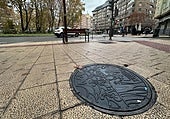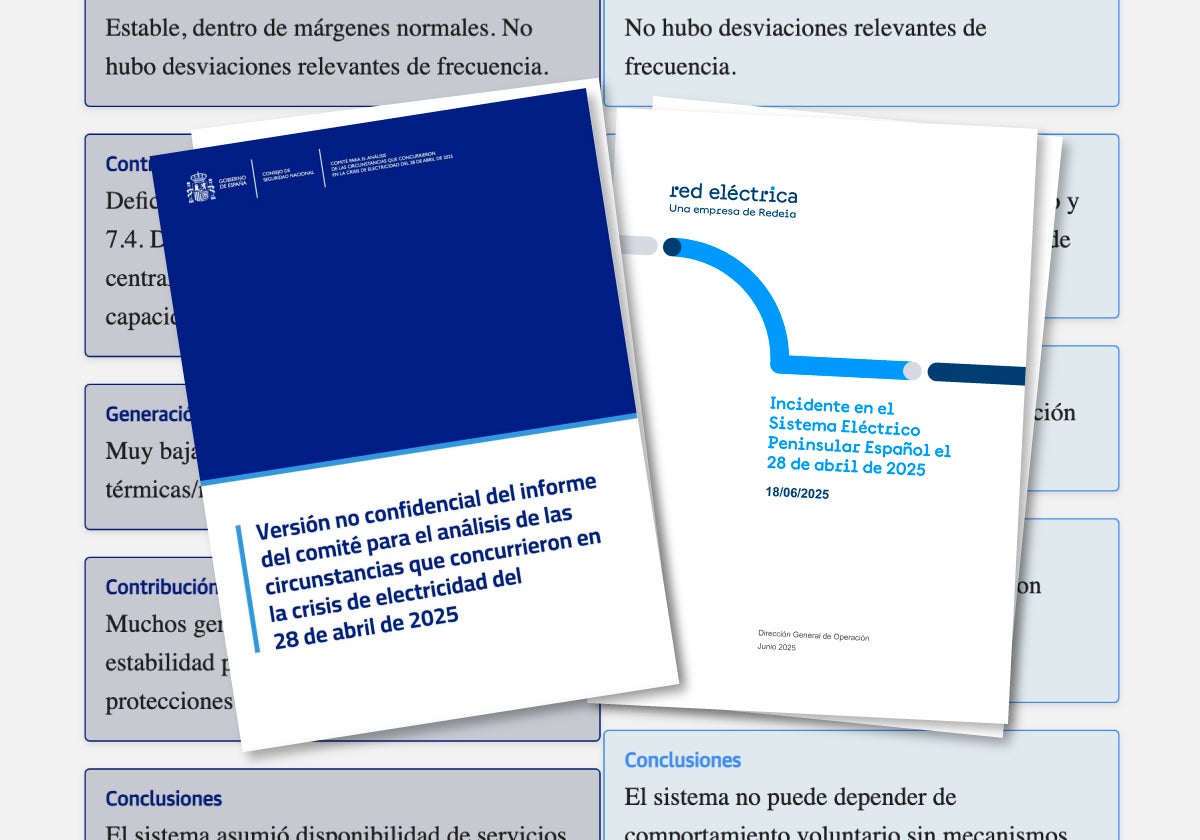A Power Outage, Two Reports, and Some Shadows: The Versions of Moncloa and Red Eléctrica on the Energy Zero
The investigation committee established by the Government released its report of over 180 pages 49 days after the blackout, while the system operator published its findings a day later in a twenty-page document.
Cristina Cándido
Thursday, 19 June 2025, 14:40
The crisis committee initiated by the National Security Council, under Moncloa and led by the Third Vice President and Minister for Ecological Transition, Sara Aagesen, unveiled its "autopsy" of the April 28 blackout on Tuesday, attributing a "multifactorial origin" as the cause that triggered a chain of failures, ultimately collapsing the electrical system. It pointed to the responsibility of both Red Eléctrica, as the operator, and the major owners of power plants.
These are the main aspects analyzed:
Causes of the Blackout

Causes of the Blackout
Multifactorial event: oscillations, incorrect disconnections, lack of reactive absorption, negative prices
Critical Moment
Between 12:32 and 12:33, massive generation loss occurs → collapse
Nature of the Incident
Cascade of failures due to lack of voltage control
First Trigger
Oscillations in a solar plant + lack of response from other facilities

Causes of the Blackout
Imbalance of reactive power balance and lack of dynamic response. It was not a frequency or inertia problem.
Critical Moment
12:32:33 unstable situation reached, protections fall → zero voltage at 12:33:24
Nature of the Incident
Voltage incident, not frequency or cyberattack
First Trigger
Initial disconnection of a renewable installation due to poor protection settings and rapid loss of reactive power
The Government points to structural stability, while the operator identifies a "forced oscillation" in a photovoltaic plant as the root cause.
Frequency and Voltage Control

Initial Frequency
Stable, within normal margins. No significant frequency deviations.
Voltage Control
Deficient, many plants did not comply with P.O. 7.4. Lack of coordination between centralized control and generation response → no capacity to dampen voltage.
Active Synchronous Generation
Very low, due to maintenance of thermal/nuclear plants and low prices.
Contribution/Distribution
Many generators did not contribute to stability due to lack of demand or poorly adjusted protections.
Conclusions
The system assumed availability of services that were not guaranteed.

Initial Frequency
No significant frequency deviations.
Voltage Control
Lack of coordination between centralized control and generation response → no capacity to dampen voltage.
Active Synchronous Generation
High renewable penetration, little generation with dynamic support capability.
Contribution/Distribution
Multiple installations detected with poorly configured protections or without automatic compliance.
Conclusions
The system cannot rely on voluntary behaviour without mandatory and automated mechanisms.
Both agree on the lack of dynamic voltage control, although the Red Eléctrica report provides more technical details and highlights specific failures in the response of certain conventional groups.
The Role of Renewables

Renewable Share in the Mix
56% renewable that day, with high solar and wind peaks.
Renewables' Contribution to the Blackout
Some renewable plants tripped without sufficient technical reason.
Problems Detected in Renewables
Non-compliance with technical regulations (P.O. 7.4), lack of dynamic response.
Individual Failures of Renewables
Solar plants with overly sensitive protections, abrupt exits due to minor oscillation.
Conclusions
Renewables cannot continue to be treated as "passive load", they must actively participate in stability.

Renewable Share in the Mix
Conditions of high renewable penetration, low demand, and low synchronous generation.
Renewables' Contribution to the Blackout
Several renewables disconnected due to protections against slight voltage rises.
Problems Detected in Renewables
Lack of regulation and technical monitoring of grid-connected plants.
Individual Failures of Renewables
Specific examples of installations that acted outside regulations without effective supervision.
Conclusions
It is urgent to review protections, dynamic control, and connection conditions of renewables.
The Government's report omits any explicit reference to the role of renewables, while the group chaired by Beatriz Corredor identifies a photovoltaic plant A, located in the province of Badajoz, as a possible origin of the 0.6 Hz oscillation and mentions failures in poorly configured protections.
Proposed Measures

Quarter-hour Market
Price signals (even negative) altered solar generation → voltage rise.
Proposed Regulatory Reforms
Mandatory voltage control service, penalties for non-compliance, data visibility.
Storage and Flexibility
Necessary to enhance storage and rapid flexibility to dampen oscillations.
Observability and Self-consumption
Propose new visibility models for renewable installations and self-consumption.
Conclusions
The current market design does not adequately incentivize system stability.

Quarter-hour Market
OMIE showed negative prices, causing voluntary exits of non-retributed generation.
Proposed Regulatory Reforms
Creation of stability service markets, greater automation, mandatory technical regulation.
Storage and Flexibility
Storage and hybridization key for stability, along with automatic response.
Observability and Self-consumption
Strong emphasis on improving observability and real-time technical control.
Conclusions
Stability cannot be left to individual economic decisions; urgent regulatory redesign is required.
The crisis committee under the Government focuses its proposals on regulation and governance of the system, while Red Eléctrica's proposals are operational and technical in nature.
Credits
-
Format Sara I. Belled





